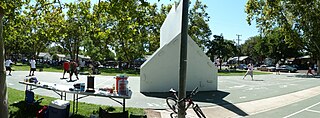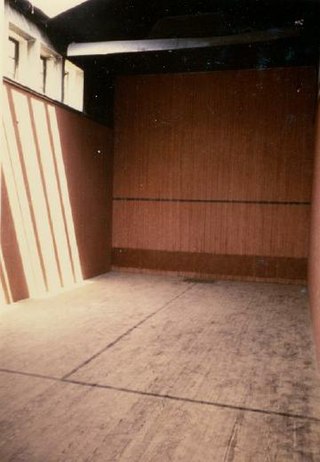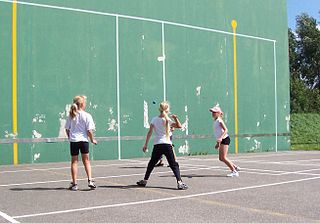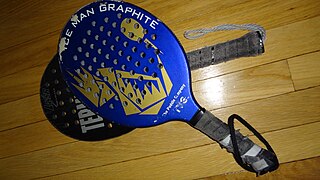
Table tennis is a racket sport derived from tennis but distinguished by its playing surface being atop a stationary table, rather than the court on which players stand. Either individually or in teams of two, players take alternating turns returning a light, hollow ball over the table's net onto the opposing half of the court using small rackets until they fail to do so, which results in a point for the opponent. Play is fast, requiring quick reaction and constant attention, and is characterized by an emphasis on spin relative to other ball sports, which can heavily affect the ball's trajectory.

Racquetball is a racquet sport and a team sport played with a hollow rubber ball on an indoor or outdoor court. Joseph Sobek invented the modern sport of racquetball in 1950, adding a stringed racquet to paddleball in order to increase velocity and control. Unlike most racquet sports, such as tennis and badminton, there is no net to hit the ball over, and, unlike squash, no tin to hit the ball above. Also, the court's walls, floor, and ceiling are legal playing surfaces, with the exception of court-specific designated hinders being out-of-bounds. Racquetball is played between various players on a team who try to bounce the ball with the racquet onto the ground so it hits the wall, so that an opposing team’s player cannot bounce it back to the wall.

Squash, sometimes called squash rackets, is a racket-and-ball sport played by two (singles) or four players (doubles) in a four-walled court with a small, hollow, rubber ball. The players alternate in striking the ball with their rackets onto the playable surfaces of the four walls of the court. The objective of the game is to hit the ball in such a way that the opponent is not able to play a valid return. There are about 20 million people who play squash regularly world-wide in over 185 countries. The governing body of squash, the World Squash Federation (WSF), is recognized by the International Olympic Committee (IOC), and the sport is included in the Olympic Games, after a number of applications. Squash has been added for the 2028 Summer Olympics in Los Angeles. The Professional Squash Association (PSA) organizes the pro tour.

Real tennis – one of several games sometimes called "the sport of kings" – is the original racquet sport from which the modern game of tennis is derived. It is also known as court tennis in the United States, royal tennis in England and Australia, and courte-paume in France. Many French real tennis courts are at jeu de paume clubs.

American handball, known as handball in the United States and sometimes referred to as wallball, is a sport in which players use their hands to hit a small, rubber ball against a wall such that their opponent(s) cannot do the same without the ball touching the ground twice or hitting out-of-bounds. The three versions are four-wall, three-wall and one-wall. Each version can be played either by two players (singles), three players (cutthroat) or four players (doubles), but in official tournaments, singles and doubles are the only versions played.

Squash tennis is an American variant of squash, one played with a ball and racquets that are more similar to the equipment used for lawn tennis, and with somewhat different rules. The game offers the complexity of squash and the speed of racquetball.
Suicide, also known as wall ball, is a game typically played by children and teenagers. The rules vary widely from place to place; those given below are not necessarily a "standard" form of the rules.
Butts Up or Wall Ball is a North American elementary school children's playground game originating in the 1950s or earlier.. It is slightly similar to the game Screen Ball, and began in the 1940s or 1950s as a penalty phase of various city street games. Butts Up is played with a ball on a paved surface against a wall, with a variable number of participants—usually more than three and often likely to exceed ten. Butts Up tends to be played during recess, before or after school.. Popular in New England is another frequent variation of wall ball that usually differs a lot from the more widely known 'Butts Up'.

Fistball is a sport of European origin, primarily played in the German-speaking nations of Austria, Germany and Switzerland, as well as in Brazil. The objective of the game is similar to volleyball, in that teams try to hit a ball over a net, but the rules vary from volleyball in several major ways. The current men's fistball World Champions are Germany, winners of both the 2023 Men's World Championships and the fistball category at the 2022 World Games, while the current women's fistball World Champions are also Germany, after winning the 2021 Women's World Championships.
Variations of basketball are games or activities based on, or similar in origin to, the game of basketball, in which the player utilizes common basketball skills. Some are essentially identical to basketball, with only minor rules changes, while others are more distant and arguably not simple variations but distinct games. Other variations include children's games, contests or activities intended to help the player practice or reinforce skills, which may or may not have a competitive aspect. Most of the variations are played in informal settings, without the presence of referees or other officials and sometimes without strict adherence to official game rules.
Stoop ball is a game that is played by throwing a ball against a stoop on the pavement in front of a building. Historically, it has been popular in Brooklyn and other inner cities. In Boston, the game is known as "Up-Against." In Chicago, the game is known as "Pinners." In Chicago's Bridgeport area the game is called "Three Outs". The game is also known as "Off the Point". It first became popular after World War II.
Several sports related to volleyball have become popular. Indoor volleyball and beach volleyball are both events at the Olympics, and sitting volleyball is an event at the Paralympics. Other varieties are localized, or are played at an amateur or informal level.

Valencian pilota is a traditional handball sport played in the Valencian Community. Its origins are not known.
Frontó is a modified Valencian pilota version of the original Basque Pelota game. The name frontó refers both to the game, ball and the playing area. Unlike some of the more popular Valencian Pilota rules, frontó is an indirect game, that is, players do not stand face-to-face but share a common playing area.

One-wall handball, also known as 1-wall, wallball or international fronton, is an indirect style of a ball game where the player hits a small rubber ball with their hand against a wall. The goal of the game is to score more points than the opponent. The player then hits the ball, and the ball bounces off the wall and the floor within court lines, if the opponent fails to return the ball, the player scores a point. The sport was created to bring together varieties, such as American handball, Basque pelota, Patball, Gaelic handball, Pêl-Law and Valencian frontó.
Variations of Australian rules football are games or activities based on or similar to the game of Australian rules football, in which the player uses common Australian rules football skills. They range in player numbers from 2 up to the minimum 38 required for a full Australian rules football.

Wallball,, is a team sport played between a various number of players per team in which players hit a bouncy ball against a wall, using their hands. The game requires the ball to be hit to the floor before hitting the wall, but in other respects is similar to squash. One player on one team may bounce the ball against the wall so a player only on the opposing team cannot bounce it back to the wall. The last person to be holding the ball after everyone is out is the winner, and their team immediately wins the game. The game requires lots of motion, and especially benefits young athletes when playing mostly at schools.
Handball is a children's ball game widely documented in Australian schools, similar to downball. The rules of the game vary considerably across different sites and conditions, but it is generally played on a flat game court with lined square zones, and involves at least two players, who each occupies a square and take turns hitting a ball with their bare hands into other player's square(s). The game is very easy to set up and can be conveniently adapted to any environments where square/rectangular-lined flat grounds can be found, such as other gyms/arenas, parking spaces and even concrete slabbed driveways and footpaths.

Paddle-ball is a sport that is played on a court half the size of a tennis court, using paddle racquets. The paddle is made of wood or graphite, and has holes to reduce air friction. The game is played with two players or in doubles.
This glossary provides definitions and context for terminology related to, and jargon specific to, the sport of pickleball. Words or phrases in italics can be found on the list in their respective alphabetic sections.










